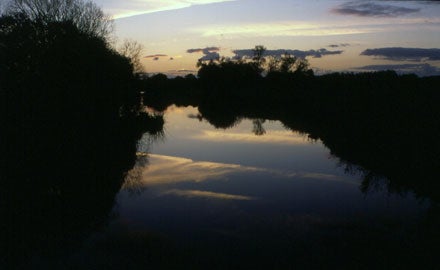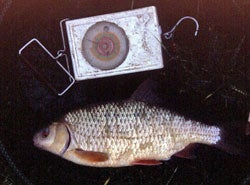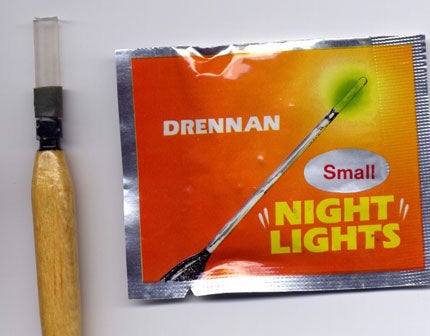| MARK WINTLE |
| Mark Wintle, an angler for thirty-five years, is on a quest to discover and bring to you the magic of fishing. Previously heavily involved with match fishing he now fishes for the sheer fun of it. With an open and enquiring mind, each week Mark will bring to you articles on fishing different rivers, different methods and what makes rivers, and occasionally stillwaters, tick. Add to this a mixed bag of articles on catching big fish, tackle design, angling politics and a few surprises. Are you stuck in a rut fishing the same swim every week? Do you dare to try something different and see a whole new world of angling open up? Yes? Then read Mark Wintle’s regular weekly column. |
ROACH AND LIGHT LEVELS The rapidly shortening evenings of autumn bring my summer evening fishing after work to a close. By mid October, I’m lucky to get an hour and a half of fishing. Some short sessions in early October reminded me of the way in which roach often come on the feed as the light fades. And with winter not far away such twilight fishing, with a few after dark sessions, is going to become a recurring theme. So what do we know of how light levels affect how roach feed? First the dace, then the roach The fishing I was doing a few weeks ago was on the tidal Frome in Wareham, Dorset. It’s close enough to home to fit in a quick session after work. The main species is dace, with a few roach if you’re lucky. Each session followed a pattern. When the light was still strong, I caught almost all dace, small ones of less than an ounce at first, but gradually the better ones that ranged anything from three ounces to nine ounces showed. I wasn’t especially after the dace, and to encourage the roach, fished with bread punch and groundbait. This isn’t the best of dace tactics but once they’re feeding, you get plenty of bites. This would take about an hour, and for the next half hour or so, with the sun still above the horizon, the dace would feed well. By this time I would have a roach or two. Then as the sun set and the light dropped rapidly, bites from dace would cease and ninety per cent of my catch from then on would be roach. These would still be feeding even when it was too dark to see the float at all. There is little doubt that if I switched my float to one taking a Starlite that I could continue to catch roach. On some occasions, when the flow has been steady, I’ve fished on, feeling the line for bites even though I’ve been floatfishing, and caught roach after roach in this manner. The roach are obviously present all the time yet not feeding. On the last occasion I fished there, one angler packed up as I arrived at 5pm. He’d fished all day and had no roach at all; just dace, and plenty of them. By the time I packed up at 7pm in the dark, a third of my catch of 40 odd fish was roach, and these were caught in the last forty minutes. It wasn’t as if the water was gin clear. It had a good colour, certainly enough to give the fish confidence to feed. When it is gin clear sometimes even the dace won’t feed until it’s nearly dark.
Walker and light meters What I’ve been describing is nothing new to seasoned roach anglers, and descriptions of catching big roach into the gloaming go back many years. The first one that I can find is Charles Wheeley in his book “Coarse Fish” written in 1896. To quote “….I have spent many a blank afternoon while roach-fishing, and taken good baskets of fish between sunset and dark, catching them even when it was too dark to see the float, tight corking, and feeling the bites.” The renowned roach angler Edward Ensom (‘Faddist’), writing in the 1930s, mentions this as well. The man that put the science into what might trigger roach into feeding in the fading light was Dick Walker. Walker was a keen photographer and took the simple expedient of using a light meter to measure the light levels at the point that the roach commenced feeding. The amount of light at the bottom must vary according to the depth and the amount of colour in the water to a degree. Those of you familiar with light meters will be interested to know that the reading from the water when the roach started to feed was around 6.5. As an experiment, I took a light meter out one day, and as it got dark, I took readings. By the time the reading gets down to 6.5, it’s dark enough that you’re struggling to see a float. As I have found in actually fishing, this moment when the roach come on is often after sunset. Sometimes they’ll feed all day It doesn’t have to be dark for the roach to feed in autumn and winter. There are many days, when in the right conditions, the roach will feed all day. But I have noticed that when clear water conditions persist towards the end of the season the roach get into a strange feeding pattern. In say, late January and early February, they start to feed around 3.30, and then as the season progresses into late February and early March the starting time gets later and later until it is either just before or actually into darkness. I first noticed this many years ago on the Wimborne stretch of the Dorset Stour. There was a junior match held from 10.00 am to 3.00pm. The half a dozen young anglers struggled for a few bleak at best. Two of us waited for the weigh-in before moving into two of the swims. We also persuaded one of the junior anglers to stay on, in his swim. He had blanked in the match but we were convinced that he would catch once the time switch kicked in. I got tackled up and we started fishing at 3.30pm. I had roach straight away, as did my mate. The junior angler decided it was time for him to start fishing again, and started catching from his seemingly fishless swim. From then on sport was brisk, and I finished with around 45 roach to a pound and a half in two hours fishing.
On the Upper Stour A more logical switch-on of roach happened to me on a millstream on the upper Stour some years previously. Here there are two weirs, one fixed and the other controlled by a mill. Because of the floods the previous week the mill sluices had been cranked open leaving the fixed weir dry, but there was sufficient flow in the river to back the water up to it, leaving it like a canal with only the flow of a tiny brook keeping the water moving. I fished it like a canal with a little waggler and bread punch but three hours fishing had only produced three or four modest roach. It was nearly dark when the roach suddenly switched on. I had a dozen big roach to well over a pound, and was left shaken when a massive roach shed the hook on the lip of the net. This afternoon’s sport at least made sense, and I suspect that if I had taken a light reading at the point when the roach did switch on then it might well have been close to the figure quoted by Dick Walker. On the tidal Stour A much more recent experience with roach took place in the last month. The tidal Stour had plenty of colour and a good flow. The fishing on the Saturday morning had been so easy as far as catching small roach from one to four ounces that after a couple of hours I went on a late season mullet hunt. The following day, I managed to fit in three hours fishing before dark on the same stretch. Initially, the tide went the wrong way and with an upstream wind, it was tricky fishing but with an hour to go before dark, it started flowing downstream again. Like the previous day the roach were in the one to four ounce bracket, despite using a large bread punch on a size fourteen. As the time diminished, I gambled on fishing a size ten, albeit a fine wire Kamasan 511. If it put the roach off the loss of less than an hours fishing was hardly a problem. In ideal conditions, the complete opposite happened. Better still, I stopped catching little roach and started getting ones from half a pound upwards to about three quarters of a pound, hardly monsters but a big improvement. Weighing up all of this, I reckon that this winter I should persevere into darkness wherever possible. If I’m confident that big roach are present, it’s a case of taking advice from the master; going up a couple of hook sizes, deepening up a bit and holding the (bread) bait still in the confident expectation of a big roach. I’m also going to do some night fishing with Starlite-adapted floats in the early evening – but that’s another story! Next week: Frost |
















